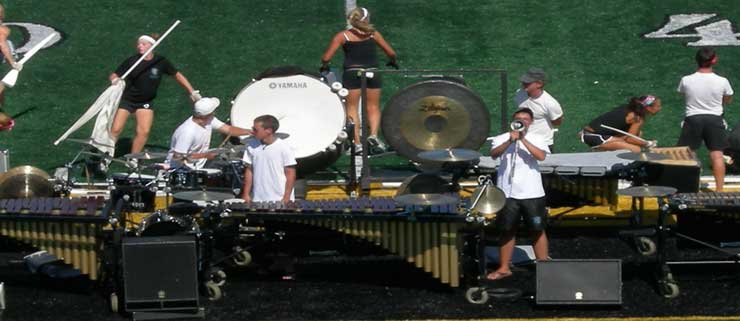Would you like students in your jazz ensemble to listen to great jazz recordings and even transcribe solos? Would you like your saxophone section to swing like Count Basie’s? Would you like your soloists to understand and use phrases invented by John Coltrane, Freddie Hubbard, J.J. Johnson, and the like? Such an accomplishment may seem daunting. If you’re like me, you’ve asked “How can my students and I find time to tackle such a thing? How do I go about teaching students to listen and transcribe?”
WEBMASTER'S NOTE: This is a three page article. Click the Next link at the bottom of each section to proceed to the next part of the article. Right click on images and select Open In New Window to see the worksheets full size.
Would you like students in your jazz ensemble to listen to great jazz recordings and even transcribe solos? Would you like your saxophone section to swing like Count Basie’s? Would you like your soloists to understand and use phrases invented by John Coltrane, Freddie Hubbard, J.J. Johnson, and the like? Such an accomplishment may seem daunting. If you’re like me, you’ve asked “How can my students and I find time to tackle such a thing? How do I go about teaching students to listen and transcribe?”
This article contains strategies that have been successful with middle school students and can apply to any age and ability. The strategies are fleshed out in three areas:
1. Building a Jazz Library...without breaking the bank
2. Guidelines for Student Listening (Download worksheets!)
3. Guidelines for Transcribing (Download worksheets!)
WORTH THE EFFORT!
I often ask my students to recall an image of someone doing an impression of someone else - whether it’s a stand up comic or someone that does a good "Mr. Fettig" behind my back. Then I ask them a rhetorical question: is it possible for a person to do an impression without ever seeing or hearing the person they are imitating? Likewise, to imitate jazz on your instrument requires that you know what it sounds like, and that requires you to listen.
There is no amount of talking and teaching that can replace a musical model for students. It’s something we all know but often forget or neglect. The first step in encouraging students to listen to jazz is to provide them with recordings to listen to.
BUILDING A JAZZ LIBRARY
Build a jazz CD library for your program. This can be done without breaking the bank; you can budget for as few as two to three CDs per year for several years. The good news is that your library will be adequate with as few as five CDs that represent the instruments in your ensemble. With a library in place, students can check out a CD to enjoy during study hall or take home for further study.
The jazz library in our middle school band room is comprised mostly of CDs from my personal collection. This is an option you may want to consider if you have jazz recordings of your own. I would not risk my personal collection had I not entered each CD onto a computer database. While it was quite an arduous task to enter all the data, it serves several purposes: to hold students accountable for returning the CDs, to keep a history of who listened to what or how many times a particular CD was checked out, and to give a jazz nerd like myself an excuse to pour over my collection. In addition, it offers me the luxury of referencing the CDs in every way imaginable; I’m able to search for all CDs that contain a particular song, instrument, date, or publisher. The ability to reference is also a helpful tool for the full jazz rehearsal. I can have students listen to original recordings of songs that they are rehearsing in the ensemble setting.
For help in determining which CDs your students should be listening to, check out www.doubletimejazz.com. You can’t go wrong with their list of "100 Historically Significant Recordings." Doubletime Jazz is also an excellent place to purchase CDs at a good price. Furthermore, Jamey Aebersold has compiled a comprehensive list of important jazz artists for each instrument.
{pagebreak}
GUIDELINES FOR STUDENT LISTENING
Listening to jazz can be accomplished on three different levels. First, students simply gain initial exposure. Students in your ensemble certainly have the capacity to appreciate jazz with a measure of sophistication, but there must first be a period of discovery. In order to accomplish this, the listening assignment must be broad and, in a word: easy. You can download the following worksheet to accomplish this “entry-level” listening:
The second level of listening requires students to identify elements of a standard small group jazz arrangement: form, head, and solos. In this activity, students’ listening will be focused on a single track as opposed to the entire CD. Students may need guidance to come up with the right answers. The initial purpose is not necessarily to assess the students’ ability to identify these advanced concepts (at first). Rather, the value is in learning terms and getting a feel for what to listen for.
The third level of listening involves internalizing the music so it can be played. This brings us to :
TRANSCRIBING: FROM LISTENING TO PERFORMANCE
Now comes the exciting part! Students are ready to implement material from the recordings into their own solos. There are two misnomers regarding this practice that need to be addressed here: 1) Transcribing jazz is too hard, and 2) Playing practiced material takes away from the improvisational nature of jazz solos.
First, transcribing is accessible to students of any ability. To play a single sustained pitch in the spirit of the jazz artist that recorded it has great value. One characteristic of great jazz artists is their ability to put meaning behind a simple two-note phrase. These simple phrases should be singled out and learned. The degree of difficulty can be increased as student progress warrants. Everyone starts somewhere.
Secondly, playing material that has been practiced and committed to finger memory is exactly what jazz artists do when they improvise. The memorized material becomes the musicians’ vocabulary list, their clichés, their catch phrases and poignant remarks. Imagine trying to speak verbally with no vocabulary or grammatical system. To improvise without these elements would be equally messy.
{pagebreak}
The activity guides students through the following transcription process:
repeated listening
identifying an excerpt they wish to learn
learning and memorizing it
writing it down
transposing it to at least one different key
It is important to set the students up for success. There are no age limits. The following transcription assignment was completed by 7th and 8th graders:
The transcription process as described here is the essence of learning to play improvised solos, from the beginning band student to the accomplished recording artist. Students who ascribe to this method will, over time, assimilate the language of jazz and gain a maturity of sound and expression. As long as basic theory isn’t neglected (notably chord-scale relationships and chord progressions), your students’ creative abilities will travel a more defined path: from the palette of transcribed material onto the canvas of an improvised solo.
CONCLUSION
There are several strategies you can use to encourage your students to listen to jazz recordings on an individual basis. You will need to build a recorded jazz library through budgeting and/or your personal collection. Before you become too discouraged by the word “budgeting”, remember that a even a handful of CDs acquired over a few years is adequate to get your students listening to jazz.
Listening assignments and activities come in three sizes and shapes. First, students express general reaction to a CD in the form of informal written description (see first example worksheet). The next level of listening requires students to identify important elements of arrangement and form (an understanding that will aid their performance). Finally, and most importantly, students can begin to learn and memorize material for use in their own improvised solo (transcribing). It is important to remember that transcribing is not an impossible task reserved for the “elite” musician; transcription of a single note is a worthy endeavor.
Have fun giving these strategies a try. I would love to hear from you as you engage your students in these important activities. Feel free to email me with your ideas, questions, or comments. I would be glad to send you any of the worksheets if you had trouble downloading them. Better yet, pay me a visit at the IAJE-WI booth at the WSMA Convention on October 28-30!
Sam Fettig
IAJE WI Vice President
Band Director, Fort Atkinson Middle School
This email address is being protected from spambots. You need JavaScript enabled to view it.







 Scroll down to view the comparison chart of over a dozen different portable digital audio recorders.
Scroll down to view the comparison chart of over a dozen different portable digital audio recorders.